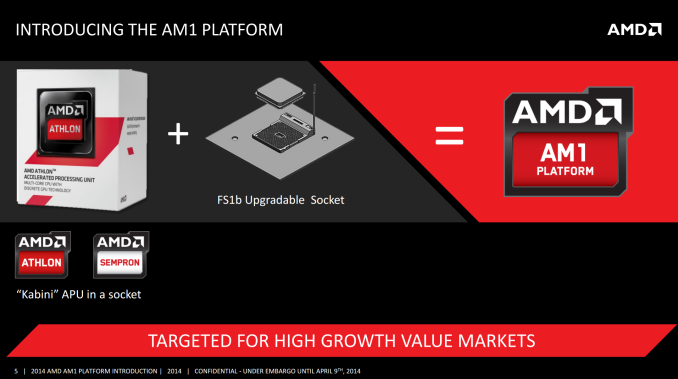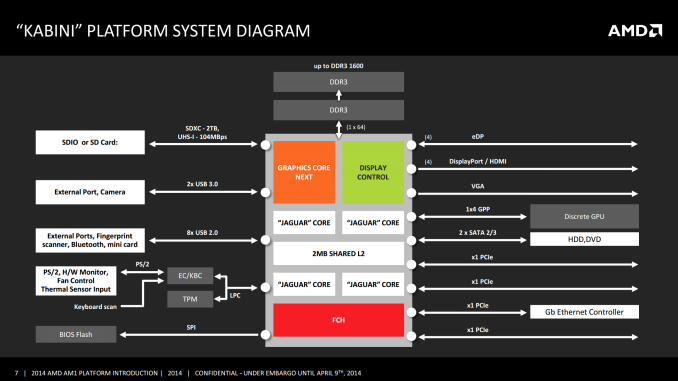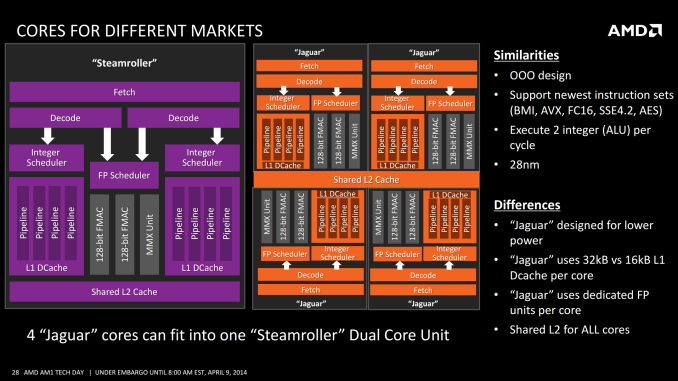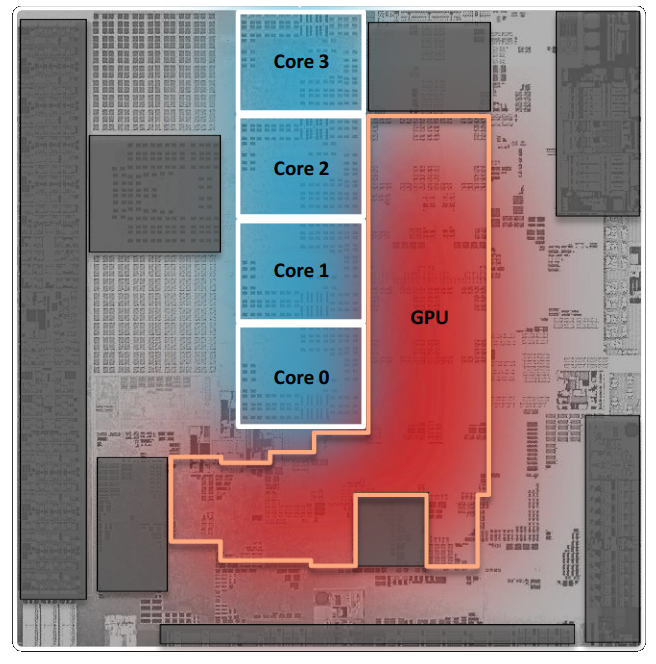AMD AM1 Kabini Part 2: Athlon 5350/5150 and Sempron 3850/2650 Tested
by Ian Cutress on May 29, 2014 2:00 PM EST
While there is a lot of focus on the mainstream desktop market, we hastily reviewed the new entrant to the low-end socketed desktop from AMD, the AM1 Kabini platform back in April. Since then we have acquired all four members of the family, the two quad core Athlon APUs and the two Sempron APUs, for testing. AMD’s movement into the upgradable tablet/desktop crossover arena is an interesting one for sure.
What Is The Point of AM1?
AMD’s reason for releasing a socketed low-power platform was derived from requests in low cost areas of the market. System integrators and companies in South America, Africa and Central Asia wanted a base system which would run an operating system which could be upgraded in the future to higher specification components, rather than sticking with a low-power but non-upgradable mobile CPU. The end result was AM1, the name given to a system using an FS1b socket with a desktop Kabini APU and an aim to build an upgradable CPU/motherboard combination for around $60.
Typically when dealing with the low cost/low power end of the spectrum, these systems are designed such that the APU is soldered on to the motherboard. When a user wants one model in particular, it comes as part of a package, much in the same way as a mobile device. In fact we even played a small game of ‘spot the desktop Kabini’ back at Computex 2013 and saw models such as the aptly named KBN-I from ECS, using the soldered A6-5200 APU:
These systems often find their way into applications that have long upgrade cycles, such as embedded and digital signage. The novelty of an upgradeable, socketed package makes most sense in the desktop arena. With low cost segments focusing more on the entry-level segmentation, AMD believe that having this upgradeability might drive pressure in the entry market towards these upgradeable PC-like devices.
AMD is marketing the series as a cheap, low powered way to go to quad core. When building a CPU architecture there is often a point in frequency scaling which is most efficient, and any deviation from that causes a less-than-linear gain in performance for power. Under this paradigm, and the importance of single core speed, the general feeling at AnandTech is that single core performance is preferred to more cores. If we can get the same multi-core performance using half the number of cores within the same power bracket, then this solution would be preferred. The final piece of that puzzle however comes in terms of design and price, both of which are points that AMD is also aiming to be competitive.
Desktop Kabini
There are a total of four AM1 APUs on the market:
| AMD AM1 Kabini APUs | ||||
| Athlon 5350 | Athlon 5150 | Sempron 3850 | Sempron 2650 | |
| CPU Cores | 4 | 4 | 4 | 2 |
| CPU Frequency | 2.05 GHz | 1.60 GHz | 1.30 GHz | 1.45 GHz |
| GPU Cores | 128 | 128 | 128 | 128 |
| GPU Frequency | 600 MHz | 600 MHz | 450 MHz | 400 MHz |
| Memory Frequency | 1600 MHz | 1600 MHz | 1600 MHz | 1333 MHz |
| L2 Cache | 2 MB | 2 MB | 2 MB | 1 MB |
| TDP | 25 W | 25 W | 25 W | 25 W |
| Official Launch Price | $59 | $49 | $39 | $31 |
Each of these APUs features up to four 28nm Jaguar cores and a 128 SP implementation of AMD's GCN GPU. We've gone over both the Jaguar and GCN architectures in previous articles, so we won't spend a lot of time recapping them here. Jaguar is the latest in AMD's line of "cat" cores, designed to go up against Intel's Atom. GCN on the other hand is a well-known GPU design from AMD as well, cut down here to fit in a much smaller die area (and thermal envelope).
The Jaguar cores in Kabini are listed as 3.1mm2, and AMD is quoting that four of these cores will fit into a single Steamroller module. Unfortunately the dimensions of a Steamroller module are not known - a 32nm SOI Bulldozer module clocked in at 30.9 mm2 for example, but no equivalent number is available for 28nm Steamroller. However some quick math shows four Jaguar cores populates 12.4 mm2. This leaves the rest of the core for the L2 cache, IGP and a large amount of IO.
In fact there are a few images that can help us predict total die size. In AMD’s slide deck, we have the following:
Given that one core is 3.1 mm2, extrapolating out gives the size of the die at 31.4x the size of a single core, or 97.3 mm2. The GPU area is approximately 5.2x the size of a core, giving ~16.1 mm2 for 128 GCN cores, compared to 12.4 mm2 for CPU cores. The Video Codec Engine and Unified Video Decoder are not part of these totals, located on other parts of the APU. The memory controller clocks in at ~9.4 mm2 and the display/IO portion runs at ~7.3 mm2.


















87 Comments
View All Comments
mikk - Thursday, May 29, 2014 - link
G1820 is missing or at least a cheap Haswell Pentium.hojnikb - Thursday, May 29, 2014 - link
Yes that would be really great, since those chips are price about the same.jospoortvliet - Sunday, June 1, 2014 - link
These do use far more power.On that note, why on earth doid the reviewer compare power usage over idle (never seen that particular metric at anandtech?!?) While not mentioning the idle power (according to various other sites, the amd's sport significant lower idle power). I don't like to think so but this is probably the only power metric to make the atoms look remotely good... Why was it chosen?
savagemike - Thursday, May 29, 2014 - link
I agree completely. If I were building a budget desktop right now that is exactly the chip (or similar) which I'd be comparing these to.MikeMurphy - Thursday, May 29, 2014 - link
I can buy a G3220 Haswell Pentium running at 3.0ghz for $60. I was really hoping this would make it into this review!!Stuka87 - Thursday, May 29, 2014 - link
The G3220 is a 53W chip. These are 25W chips. They do not compete with each other.HisDivineOrder - Friday, May 30, 2014 - link
Atom chips are 10W chips. These Semprons are 25W. They do not compete with each other.See how that doesn't impact the fact that people are talking about more than just wattage? ;) Some people just want to know what the best VALUE is per dollar and these low end options are all in the running.
Why limit yourself to just discussing wattage-appropriate? Especially when those Semprons are already over twice the Atom chips in terms of watts.
bsim500 - Friday, May 30, 2014 - link
"The G3220 is a 53W chip. These are 25W chips. They do not compete with each other."Intel's TDP is way overstated on its dual-cores. My "55w" i3 pulls about 32w in reality (measured at the wall, not calculated). I've seen Haswell Pentium's that are sub-30w, (full speed not the slow "T" variants). They are very definitely in the same bracket. In fact, at stock 3.4GHz, with a -0.15v undervolt, I can get my "77w" i5-3570 down from a measured 59w (1.1v) to around 47w (0.95v). At 3.0GHz at 0.83v, you're looking at 36w 4T / 25w 2T (for an i5). AMD's Kabini's are still on 28nm vs Intel's 22nm, and you'd be surprised just how low you can go with undervolting the latter's "big cores".
silverblue - Friday, May 30, 2014 - link
The point is moot as AMD is known for overvolting its processors; an article on Kabini would be very interesting.lyeoh - Sunday, June 1, 2014 - link
Which is why this article needs some actual power consumption benchmarks.